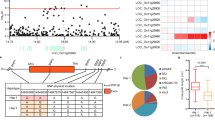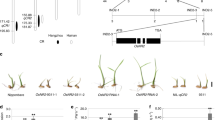Abstract
Global socioeconomic developments create strong incentives for farmers to shift from transplanted to direct-seeded rice (DSR) as a means of intensification and economization1. Rice production must increase to ensure food security2 and the bulk of this increase will have to be achieved through intensification of cultivation, because expansion of cultivated areas is reaching sustainable limits3. Anaerobic germination tolerance, which enables uniform germination and seedling establishment under submergence4, is a key trait for the development of tropical DSR varieties5,6. Here, we identify a trehalose-6-phosphate phosphatase gene, OsTPP7, as the genetic determinant in qAG-9-2, a major quantitative trait locus (QTL) for anaerobic germination tolerance7. OsTPP7 is involved in trehalose-6-phosphate (T6P) metabolism, central to an energy sensor that determines anabolism or catabolism depending on local sucrose availability8,9. OsTPP7 activity may increase sink strength in proliferating heterotrophic tissues by indicating low sugar availability through increased T6P turnover, thus enhancing starch mobilization to drive growth kinetics of the germinating embryo and elongating coleoptile, which consequently enhances anaerobic germination tolerance.
This is a preview of subscription content, access via your institution
Access options
Subscribe to this journal
Receive 12 digital issues and online access to articles
$119.00 per year
only $9.92 per issue
Buy this article
- Purchase on Springer Link
- Instant access to full article PDF
Prices may be subject to local taxes which are calculated during checkout



Similar content being viewed by others
References
Kumar, V. & Ladha, J. K. in Advances in Agronomy, Vol. 111 (ed. Sparks, D. L. ) 297–413 (Elsevier Academic Press Inc, 2011).
Godfray, H. C. J. et al. Food security: the challenge of feeding 9 billion people. Science 327, 812–818 (2010).
Foley, J. A. et al. Solutions for a cultivated planet. Nature 478, 337–342 (2011).
Magneschi, L. & Perata, P. Rice germination and seedling growth in the absence of oxygen. Ann. Bot. 103, 181–196 (2009).
Ismail, A. M., Ella, E. S., Vergara, G. V. & Mackill, D. J. Mechanisms associated with tolerance to flooding during germination and early seedling growth in rice (Oryza sativa). Ann. Bot. 103, 197–209 (2009).
Septiningsih, E. M. et al. QTL mapping and confirmation for tolerance of anaerobic conditions during germination derived from the rice landrace Ma-Zhan Red. Theor. Appl. Genet. 126, 1357–1366 (2013).
Angaji, S., Septiningsih, E., Mackill, D. & Ismail, A. QTLs associated with tolerance to flooding during germination in rice (Oryza sativa). Euphytica 172, 159–168 (2010).
Paul, M. J. Trehalose 6-phosphate: a signal of sucrose status. Biochem J 412, 1–2 (2008).
Zhang, Y. et al. Inhibition of SNF1-related protein kinase1 activity and regulation of metabolic pathways by trehalose-6-phosphate. Plant Physiol. 149, 1860–1871 (2009).
Sasaki, K. et al. Fine mapping of a major quantitative trait locus, qLG-9, that controls seed longevity in rice (Oryza sativa L.). Theor. Appl. Genet. TAG. 128, 769–778 (2015).
Schatz, M. C. et al. Whole genome de novo assemblies of three divergent strains of rice, Oryza sativa, document novel gene space of aus and indica. Genome Biol. 15, 506 (2014).
3,000 Rice Genomes Project. The 3,000 rice genomes project. Gigascience 3, 7 (2014).
Lasanthi-Kudahettige, R. et al. Transcript profiling of the anoxic rice coleoptile. Plant Physiol. 144, 218–231 (2007).
Kordan, H. A. Oxygen as an environmental factor in influencing normal morphogenetic development in germinating rice seedlings. J. Exp. Bot. 27, 947–952 (1976).
Voesenek, L. A. C. J. & Bailey-Serres, J. Flood adaptive traits and processes: an overview. New Phytol. 206, 57–73 (2015).
Edwards, J. M., Roberts, T. H. & Atwell, B. J. Quantifying ATP turnover in anoxic coleoptiles of rice (Oryza sativa) demonstrates preferential allocation of energy to protein synthesis. J. Exp. Bot. 63, 4389–4402 (2012).
Loreti, E., Yamaguchi, J., Alpi, A. & Perata, P. Sugar modulation of alpha-amylase genes under anoxia. Ann. Bot. 91 Spec No, 143–148 (2003).
Park, M. et al. Interference with oxidative phosphorylation enhances anoxic expression of rice alpha-amylase genes through abolishing sugar regulation. J. Exp. Bot. 61, 3235–3244 (2010).
Lee, K.-W. et al. Coordinated responses to oxygen and sugar deficiency allow rice seedlings to tolerate flooding. Sci. Signal. 2, ra61 (2009).
Lee, K.-W., Chen, P. W. & Yu, S.-M. Metabolic adaptation to sugar/O2 deficiency for anaerobic germination and seedling growth in rice. Plant Cell Environ. 37, 2234–2244 (2014).
Ge, L.-F. et al. Overexpression of the trehalose-6-phosphate phosphatase gene OsTPP1 confers stress tolerance in rice and results in the activation of stress responsive genes. Planta 228, 191–201 (2008).
Shima, S., Matsui, H., Tahara, S. & Imai, R. Biochemical characterization of rice trehalose-6-phosphate phosphatases supports distinctive functions of these plant enzymes. FEBS J. 274, 1192–1201 (2007).
Yadav, U. P. et al. The sucrose-trehalose 6-phosphate (Tre6P) nexus: specificity and mechanisms of sucrose signalling by Tre6P. J. Exp. Bot. 65, 1051–1068 (2014).
Lawlor, D. W. & Paul, M. J. Source/sink interactions underpin crop yield: the case for trehalose 6-phosphate/SnRK1 in improvement of wheat. Front Plant Sci. 5, 418 (2014).
O'Hara, L. E., Paul, M. J. & Wingler, A. How do sugars regulate plant growth and development? New insight into the role of Trehalose-6-Phosphate. Mol. Plant 6, 261–274 (2012).
Lunn, J. E., Delorge, I., Figueroa, C. M., Van Dijck, P. & Stitt, M. Trehalose metabolism in plants. Plant J. 79, 544–567 (2014).
Schluepmann, H., Pellny, T., van Dijken, A., Smeekens, S. & Paul, M. Trehalose 6-phosphate is indispensable for carbohydrate utilization and growth in Arabidopsis thaliana. Proc. Natl Acad. Sci. USA 100, 6849–6854 (2003).
Polge, C. & Thomas, M. SNF1/AMPK/SnRK1 kinases, global regulators at the heart of energy control? Trends Plant Sci. 12, 20–28 (2007).
Lu, C.-A. et al. The SnRK1A protein kinase plays a key role in sugar signaling during germination and seedling growth of rice. Plant Cell 19, 2484–2499 (2007).
Radchuk, R. et al. Sucrose non-fermenting kinase 1 (SnRK1) coordinates metabolic and hormonal signals during pea cotyledon growth and differentiation. Plant J. 61, 324–338 (2010).
Martínez-Barajas, E. et al. Wheat grain development is characterized by remarkable trehalose 6-phosphate accumulation pregrain filling: tissue distribution and relationship to SNF1-related protein kinase1 activity. Plant Physiol. 156, 373–381 (2011).
Valluru, R. & Van den Ende, W. Myo-inositol and beyond—emerging networks under stress. Plant Sci. 181, 387–400 (2011).
Narsai, R., Rocha, M., Geigenberger, P., Whelan, J. & van Dongen, J. T. Comparative analysis between plant species of transcriptional and metabolic responses to hypoxia. New Phytol. 190, 472–487 (2011).
Narsai, R. et al. Mechanisms of growth and patterns of gene expression in oxygen-deprived rice coleoptiles. Plant J. 82, 25–40 (2015).
Toledo, A. M. U. et al. Development of improved Ciherang-Sub1 having tolerance to anaerobic germination conditions. Plant Breed. Biotech. 3, 77–87 (2015).
Luo, M. & Wing, R. A. An improved method for plant BAC library construction. Methods Mol. Biol. 236, 3–20 (2003).
Alexandrov, N. et al. SNP-Seek database of SNPs derived from 3000 rice genomes. Nucleic Acids Res. 43, D1023–D1027 (2015).
Slamet-Loedin, I., Chada-Mohanty, P. & Torizzo, L. Agrobacterium-mediated transformation: rice transformation. Methods Mol. Biol. 1099, 261–271 (2014).
Ella, E. S., Dionisio-Sese, M. L. & Ismail, A. M. Seed pre-treatment in rice reduces damage, enhances carbohydrate mobilization and improves emergence and seedling establishment under flooded conditions. AoB Plants 2011, plr007 (2011).
Lisec, J., Schauer, N., Kopka, J., Willmitzer, L. & Fernie, A. R. Gas chromatography mass spectrometry-based metabolite profiling in plants. Nature Protoc. 1, 387–396 (2006).
Acknowledgements
We thank I. Tamisin, J. Mendoza, G. Reynaldo, P. Sendon, J.C. Ignacio, C. Casal, D. Sanchez, G. Vergara, S. Catausan, L. Torrizo, C. Duenas, R. Anacleto and C. Llorente for technical assistance; D. Kudrna, W. Golser, J. Talag and R. Wing from Arizona Genomics Institute (AGI) for providing BAC clones, Metabolomic Discoveries GmbH for quantification of sucrose, trehalose-6-phosphate (T6P) and trehalose. This work was supported by the Stress Tolerant Rice for Africa and South Asia (STRASA) project funded by the Bill and Melinda Gates Foundation (BMGF), Global Rice Science Partnership (GRiSP), a grant from the German Federal Ministry of Economic Cooperation and Development (BMZ) #81157485 to E.M.S. and A.M.I, and the US National Science Foundation #IOS-1121626 to J.B.-S. T.K's fellowship was supported by a BMZ Post Doc grant to E.M.S. and R.A.'s PhD was supported by the Monsanto Beachell-Borlaug International Scholars Program (MBBISP) under supervision of J.B.-S. and E.M.S.
Author information
Authors and Affiliations
Contributions
E.M.S., T.K., D.J.M. and A.M.I. designed the experiments; E.M.S. fine-mapped the QTL; K.R.T. developed the OX lines; L.F.G. performed phenotyping in the laboratory; J.B.-S. assisted in analysing RNA-Seq data; R.A. performed qRT–PCR; N.S. and R.J. performed metabolomics profiling; T.K. with assistance of M.A.P. performed the rest of the experiments; J.B.-S and M.S.M. provided advice about the experiments; I.S.-L. provided technical assistance and infrastructure for rice transformation; T.K. and E.M.S. wrote the manuscript; J.B.-S., N.S., D.J.M. and A.M.I. edited the manuscript; all authors read and approved the manuscript.
Corresponding author
Ethics declarations
Competing interests
The authors declare no competing financial interests.
Rights and permissions
About this article
Cite this article
Kretzschmar, T., Pelayo, M., Trijatmiko, K. et al. A trehalose-6-phosphate phosphatase enhances anaerobic germination tolerance in rice. Nature Plants 1, 15124 (2015). https://doi.org/10.1038/nplants.2015.124
Received:
Accepted:
Published:
DOI: https://doi.org/10.1038/nplants.2015.124
This article is cited by
-
Characterization and in silico analysis of the domain unknown function DUF568-containing gene family in rice (Oryza sativa L.)
BMC Genomics (2023)
-
A comprehensive analysis of copy number variations in diverse apple populations
BMC Genomics (2023)
-
Comparative transcriptomic analysis of germinating rice seedlings to individual and combined anaerobic and cold stress
BMC Genomics (2023)
-
Singlet oxygen-induced signalling depends on the metabolic status of the Chlamydomonas reinhardtii cell
Communications Biology (2023)
-
Two complementary genes in a presence-absence variation contribute to indica-japonica reproductive isolation in rice
Nature Communications (2023)



